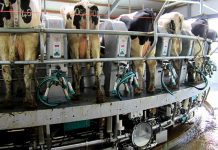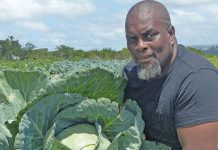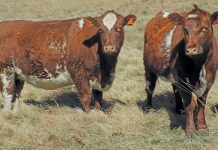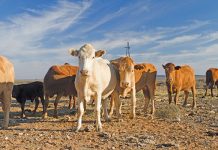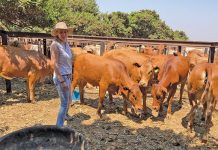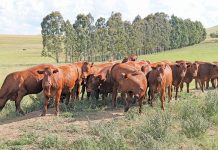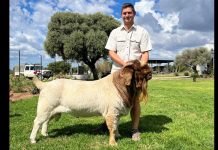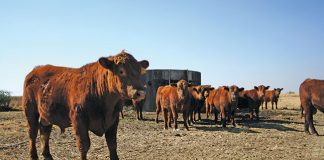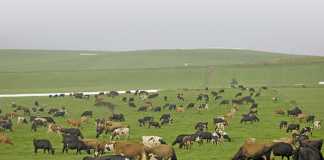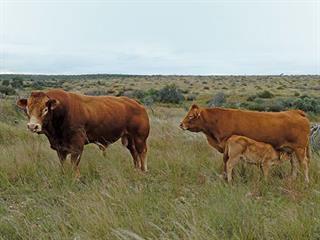
Sigi Baas comes from pioneering stock. His grandfather emigrated from Germany to Namibia (then South West Africa) and worked as a bricklayer for three years to earn enough to buy 4 700ha of bare land – Ombuerendende – in 1915. Sigi and his wife Heide took over the farm, which is near Omitara, 100km east of Windhoek, from Sigi’s parents in 1992 and acquired a second block of land in 2001. Together, the two farms cover 8 000ha.
Reflecting on the farm’s modest beginnings, Sigi explains that securing a steady water supply was the first priority. “My grandparents built a dam with their hands, an ox and a ‘skrop’ (scraper). For months on end, they excavated a low-lying section of the land and built a dam wall. This dam is today still one of our main reservoirs on the farm,” he says.
The land consists of savannah and bushveld with an average annual rainfall of between 300mm and 400mm. Sigi maintains a stocking rate of 8ha/ MLU, but this was not always the case. In the past, bush encroachment had slowly reduced the carrying capacity. In 1992, the stocking rate was as low as 20ha/MLU.
“This affected our financial bottom line,” he recalls. “We had the choice of buying new land or combating bush encroachment. We decided to deal with the bush, and tested several ways to get rid of excessive sickle bush (Dichrostachys cinerea) and black thorn (Acacia mellifera).”
Spraying by hand
Removing the bush mechanically was too expensive. However, hormone-based arboricide marketed under the commercial names of Molopo, Limpopo and Savannah, and registered for the eradication of perennial woody plants, proved to be highly effective. Although it was labour-intensive and time-consuming, it increased the carrying capacity dramatically. Sigi and his team walked through the veld, spraying the plants. The application rate averaged 1l/ha, depending on the density of the invader species.
During the rainy season, a 2m high black thorn tree uses as much as 65l of water daily, says Sigi. “This means that 195 000l/ha is used daily on Ombuerendende at an average black thorn density of 3 000 trees/ha. Given our relatively low annual rainfall, the past decade’s bush clearing has changed high-risk farming to low-risk farming. Annual grass production has climbed from 120kg/ ha to 852kg/ ha. Farm income rose from R25/ha in 1992 to R70/ha in 2004. So we could increase the size of our breeding herds by 30% and increase our profit margins,” he explains.
The grass component consists of wool grass (Anthephora pubescens), buffalo grass (Cenchrus ciliaris), silky Bushman grass (Stipagrostis uniplumis) and black-footed signal grass (Brachiaria nigropedata). The woody component includes bastard umbrella thorn (Acacia luederitzii), brandybush (Grewia flava) and trumpet thorns (Cataphractes alexandri).
Commercial herd
The Ombuerendende commercial herd consists of 230 Brahman cross Limousin breeding cows maintaining a 90% calving rate per cow mated. Initially, Sigi and Heide produced slaughter oxen off the veld, but found it difficult to get oxen slaughter-ready on veld before 36 months.
“For the past three years we haven’t castrated the bulls,” Sigi says. “We have enough land, so we put the young bulls on a different part of the farm away from the heifers and cows. We sent our first batch of bulls to slaughter in January and February this year. The aim is to produce at least 100 slaughter bulls annually.”
Sigi says that the growth rate of the bulls exceeds that of oxen by far and they can market them at between 18 and 20 months. This is where Limousin genetics plays a decisive role. They keep most heifers as replacement heifers and sell the balance as breeding stock.
Stud
Sigi and Heide started breeding Limousins in 2005 in co-operation with Namboer’s Piet Coetzee. The partnership split in March 2014 and the Baas’s stud continued as Ombende Limousins. “We must breed cattle that are fertile and well-adapted to Namibian conditions,” Sigi stresses. “We need exceptional growth, above-average muscling, a high slaughtering percentage, and calving ease. Fertility is crucial. The Limousin is the breed best suited to our requirements.
“By combining Limousin with Brahman, we increased our average weaning weight from 200kg in 2005 to 265kg in 2013.” The ideal cross consists of 65% Brahman and 35% Limousin. One of the couple’s objectives is to market slaughter animals as early as possible. For that, the Limousin’s rapid growth is essential.
“We tried crossbreeding with several other breeds, but the Limousin cross came out tops every time. It’s known for its exceptional muscling, growth ability, ability to adapt to various climates, and longevity. Ombende Limousins’ muscle is due to breeding, not feeding.”
The Ombende Limousin stud currently consists of 25 cows, three bulls, 30 heifers and 30 young bulls. The plan is to increase the stud herd to 50 breeding cows. As the commercial herd brings in the main income, the stud has to be compact and efficient, and breed the best possible genetics – to add value to the commercial herd and to other commercial cattlemen as well as to contribute to a healthy Limousin genetic base in Namibia.
Stock theft does not pose a serious problem, as Ombuerendende is far from main roads and not easily accessible. Despite this, the breeding herds are inspected daily and all cattle are counted regularly.
Animal recording
Performance testing and animal recording are integral to the enterprise. The lineage of every calf born on Ombuerendende, whether stud or commercial, can be traced back to its dam and sire. Every animal on the farm carries a numbered ear tag to keep track of it.
“For stud animals, we record birth weight and 200-, 400- and 600-day weights,” says Sigi. “The average Limousin birth weight is 37kg, average weaner weight is 200kg, average 200-day weight is 240kg, average 400-day weight is 347kg, and average 600- day weight is 420kg. We also record mature cow weight (average 590 kg) and 600-day scrotal circumference in bulls (average 35cm). Our average ICP (inter-calving period) is 411 days.”
Sigi emphasises that receiving the award for the Namibian Limousin stud with the best ICP in 2013 was an important achievement for them and underscores the importance of proper record keeping. “Because of our stud’s relatively small size, we select only the top- performing animals for a sound genetic base. We market a limited number of stud bulls every year and are committed to providing the best genetics to our clients.”
As the Namibian gene pool is still relatively small, Sigi sources new genetic material primarily from South African breeders, mostly from the La Rhone stud owned by the Du Toit family, in Tulbagh. For three years, when the border between South Africa and Namibia was closed due to SA’s foot-and-mouth disease status at the time, the Du Toits cared for the Sigi’s animals and their progeny. For this, says Sigi, he is eternally grateful.
Management
The Limousin stud animals run on the veld throughout the year with only summer and winter licks. The farm is divided into 22 camps from 100ha to 250ha in size, with seven shared watering points. A rotational grazing programme leaves half of the camps fallow during the rainy season to ensure sufficient grazing during the dry season. The herd follows a summer and winter single-sire breeding programme at one bull per 30 cows.
“Two breeding seasons are easier to manage and we don’t need as many bulls as with a single season system,” explains Sigi. “We don’t artificially inseminate because we farm very extensively.” A strict vaccination programme sees all animals vaccinated against anthrax, black quarter and brucellosis each February, as required by Namibian legislation, as well as annually against bovine viral diarrhoea (BVD). Sigi has found that the general health and fertility and calving rate of the Ombuerendende herd have increased significantly since he began injecting MultiMin twice a year in 2010. Annual vaccination with Pilliguard prevents eye diseases.
Predation
Since Sigi and Heide started using donkeys 12 year ago, predation by black-backed jackal has largely been contained.
“We’re against the use of traps and poison,” says Sigi. “Running donkeys with the cattle has been very successful. We keep mares with foals with the cow herds because they instinctively attack predators.”
However, he adds that bush clearing has led to increased grass cover, providing jackal with an improved habitat. “Keeping donkeys in the bull herds also helps to stop them fighting. They keep aggressors apart.” The couple also runs a 300-strong Damara sheep stud, mainly to provide breeding material and meat. Trophy hunting further supplements the farm’s income.
Teamwork works
“Heide and I, our two daughters Christine and Gabriele and our farm workers all work together as a team to steer the farm forward,” Sigi says, and ascribes a large part of Ombuerendende’s success to Heide. “Behind every successful man is a strong and successful woman. Heide is responsible for the financial management, administration, bookkeeping, record-keeping and correspondence. Technology really intimidates me; if it weren’t for her computer proficiency, record-keeping would have been difficult.”
Phone Sigi and Heide Baas on 00264 62 560229 or 00264 812419909. Email [email protected].

